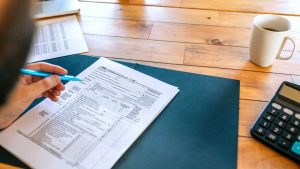Are you a freelancer, a self-employed individual, or running a small business? If so, then you’ve probably heard about the UTR Number. But do you know what it is and why it’s important? Don’t worry! In this blog post, we’ll walk you through everything you need to know about applying for a UTR Number and the simple steps involved in the process.
Having a Unique Taxpayer Reference Number is crucial whether you’re just starting or have been in business for some time. It helps HM Revenue and Customs identify your tax records and calculate your taxes correctly. So, if you want to stay on top of your financial obligations and avoid any unnecessary penalties or fines, read on to find out how easy it is to apply for a UTR Number. Let’s dive right in!
What is a UTR Number?

A UTR Number, or Unique Taxpayer Reference, is a 10-digit code assigned to individuals and businesses in the United Kingdom by HM Revenue and Customs (HMRC). It is a unique identifier for your tax records and helps ensure your taxes are accurately calculated. Think of it as your personal tax reference number.
Your UTR Number stays with you throughout your lifetime, even if you change jobs or start a new business. It’s an essential piece of information that you’ll need whenever you interact with HMRC regarding your tax affairs. So whether it’s filing self-assessment tax returns, paying taxes owed, or communicating with HMRC about any changes in circumstances, having a UTR Number is vital for staying compliant and keeping track of your financial obligations.
Why do I Need a UTR Number?
A UTR (Unique Taxpayer Reference) number is a unique identifier assigned to individuals and businesses by HM Revenue and Customs (HMRC) in the UK. But why do you need one? Having a UTR number is essential if you are self-employed or have income that your employer’s Pay doesn’t cover the As You Earn (PAYE) system, such as rental income or freelance work.
Having a UTR number allows HMRC to track your tax obligations accurately. It ensures that you pay the correct tax on your self employed earnings or other forms of untaxed income. You can submit your Self-assessment tax return online with a UTR number or access other digital services HMRC provides. So whether you’re running a small business or earning additional income outside of employment, obtaining a UTR number is crucial for staying compliant with UK taxation laws.
How to Find Your UTR Number?
What is a UTR Number? How to Find Your UTR Number? These are common questions among individuals who must register for a UK Unique Taxpayer Reference number. If you’re wondering how to find your UTR number, there are several ways.
The first step is to check any correspondence or documentation from HM Revenue and Customs (HMRC). Your UTR number may be listed on letters related to tax returns or self-assessment forms. Additionally, if you have registered for Self-Assessment online, you can log into your account and find your UTR number under the “Self-Assessment” section.
How to Apply for UTR Number Online?

Applying for a UTR number online is a convenient and efficient way to obtain this important identifier. To begin the process, you must visit the official website of HM Revenue and Customs. Look for the option to register for Self-Assessment and follow the instructions provided. You will be asked to provide personal details such as your name, address, National Insurance number, and contact information. Once the application form is finished, send it electronically via the website. After that, HMRC will review your application and send you a letter with your UTR number.
Remember to double-check all the data you supply during the online application process to guarantee accuracy. If any mistakes are made, or additional documentation is required, HMRC may request further clarification before issuing your UTR number. Applying online allows quick processing times and eliminates the need for paper forms or postal delays. It’s an efficient way to get your UTR number without leaving home!
1. How to Apply for a UTR Number through Phone?
Applying for a UTR number by phone is another convenient option. You must call the Self-Assessment helpline HMRC provided to do so. The representative on the other end of the line will guide you through the application process and help answer any questions or concerns. Having all your details and relevant information ready when calling is important, as this will expedite the process. Once your application is complete, HMRC will send your UTR number to you via post within a few weeks.
Applying for a UTR number over the phone can save time and effort, especially if you prefer speaking with someone directly rather than navigating an online platform. Just gather all the necessary information beforehand to ensure a smooth application experience.
2. How to Apply for a UTR Number by Post?
To apply for a UTR number by post, you must download and fill out the form “SA1 – Registering for Self-Assessment and getting a tax return.” This form is on the official HM Revenue & Customs (HMRC) website. Ensure you provide accurate information about your details, employment status, income sources, and other relevant information.
Once you have completed the form, double-check that all sections are filled correctly. Include any additional documents or evidence as requested in the instructions. Then, mail the completed form along with supporting documents to the address provided on the form. It’s essential to keep copies of everything you send for your records.
What Information is Required to Register for a UTR Number?

When registering for a UTR number, you must provide certain information. First and foremost, you will need your details, such as your full name, date of birth, and current address. This is necessary so that HM Revenue & Customs can accurately identify you as the taxpayer.
Additionally, you will be asked for your National Insurance Number. This unique identifier helps HMRC link your tax records across different systems and ensures accuracy in their calculations. It is important to have this information readily available when applying for a UTR number online or by phone.
When registering for a UTR number, have your full name and address on hand and your National Insurance Number. These pieces of information are essential in establishing your identity with HMRC and ensure smooth application processing without any delays or issues.
What to Do if You’ve Lost Your UTR Number?
Losing your UTR number can be frustrating, but there’s no need to panic. If you find yourself in this situation, the first step is to contact HM Revenue and Customs (HMRC) for assistance. They have a dedicated helpline for individuals who have lost their UTR numbers.
When contacting HMRC, please provide them with all the information they require to verify your identity. This may include personal details such as your full name, address, date of birth, and National Insurance number. Once they have confirmed your identity, they can retrieve your lost UTR number and provide it to you.
When Should You Register for a UTR Number?
When should you register for a UTR number? It’s important to apply for a UTR number as soon as you start earning income that needs to be reported to HM Revenue and Customs (HMRC). Registering for a UTR number is crucial whether you’re self-employed, a freelancer, or earning income from rental properties.
By obtaining a UTR number early on, you ensure you comply with tax regulations and avoid penalties. Even if your earnings fall below the current threshold for paying taxes, it’s still recommended to register for a UTR number. This way, HMRC can keep track of your financial activities and provide relevant guidance when necessary. Take proactive steps by registering for your UTR number today.
How to Close Your UTR Number?

Closing your UTR number is a simple process that can be done online or by contacting HM Revenue and Customs (HMRC) directly. To close your UTR number online, log into your HMRC online account and select the option to close your self-assessment record. Alternatively, you can contact the Self-Assessment helpline and inform them of your intention to close your UTR number.
When closing your UTR number, it is important to ensure that all outstanding tax returns have been submitted and that any tax liabilities have been paid in full. Once you have successfully closed your UTR number, HMRC will send you closure confirmation for your records. Remember to keep this documentation safe as proof of closure if required.
Conclusion
Applying for a UTR number may seem daunting, but quite straightforward. Whether you apply online, by phone, or by post, the process can be completed in just a few simple steps.
A UTR number is essential if you are self-employed or earning income through freelancing or other means outside of regular employment. It helps ensure you are correctly registered with HMRC and fulfil your tax obligations.
To find your UTR number, check any previous correspondence from HMRC or log in to your online account. If you’ve lost your UTR number, don’t worry – there are ways to retrieve it online or by contacting HMRC directly.
Ensure you have all the necessary information when applying for a UTR number. This includes personal details such as your name and address, national insurance number, date of birth, contact information and relevant financial records.
Registering for a UTR number as soon as possible is important once you earn taxable income outside of regular employment. Failure to do so can result in penalties and unnecessary stress later on.
If you need to close your UTR number due to changes in circumstances or no longer being self-employed, inform HMRC promptly so they can update their records accordingly.
In conclusion, obtaining a UTR number can be simple. By following the simple steps outlined above and ensuring that all required information is provided accurately during the application process, you’ll be well on your way towards easily meeting your tax responsibilities.









